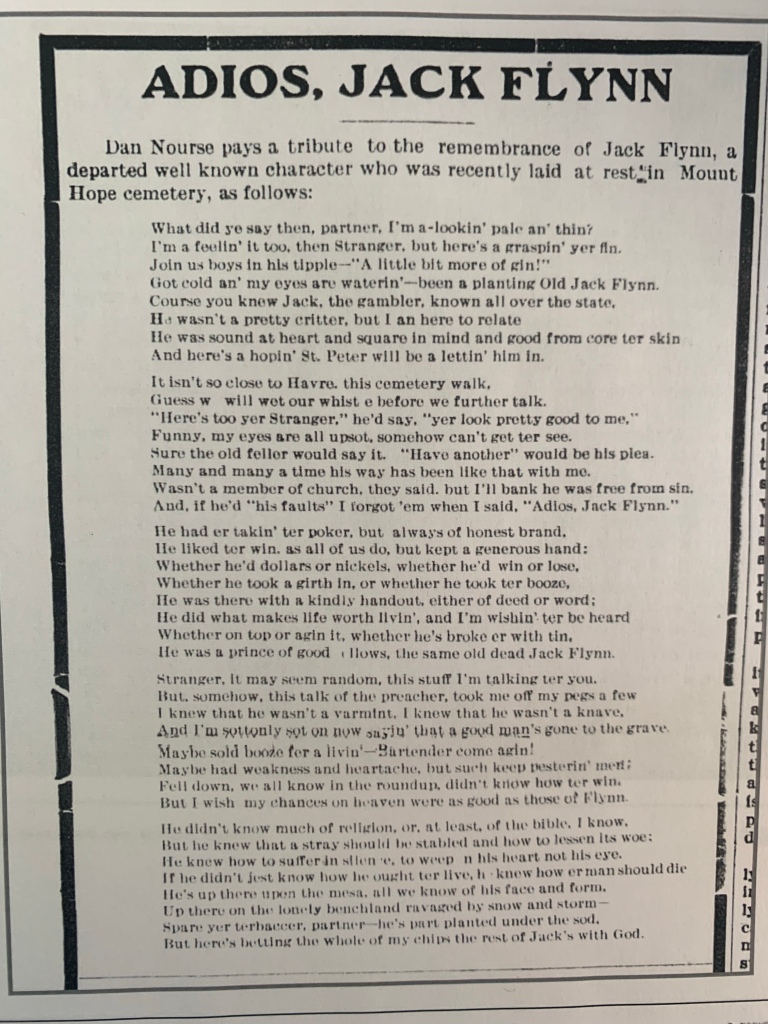
North of Chinook are two adjacent late 19th centuries. The earliest is the Kuper Memorial Cemetery, originally known as the Chinook Cemetery. From newspaper accounts, burials there date to at least 1894 when former Canadian lumberman Gilbert McIntosh was laid to rest. Chinook newspapers also note that St. Gabriel’s Catholic Cemetery, immediately south of the city cemetery, dates to 1898 when prominent Catholic civic leader Thomas O’Hanlon was the first person to be buried in the new Catholic cemetery. The Chinook Opinion of February 17, 1898, called O’Hanlon “practically the founder of this little city and its interests have been his own for eight years passed [or 1890].”


For its first generation the two cemeteries lacked water and regular upkeep. Chinook women tackled the problem first. In 1910 a Ladies Cemetery Committee formed to raise “money for the Cemetery fund which is to be used in beautifying the Chinook cemetery grounds.” [Chinook Opinion 11/3/1910] The women served meals on Election Day, charging 50 cents a meal. “The bill of fare will consist of chicken pie, mashed potatoes, salads, pickles, cake, bread and butter, pie and coffee.”
The grave markers below reflect the different types found in the cemetery by 1910.




The following year Chinook women hosted a recital by Mrs. Riggs to raise funds for the city cemetery. By the fall of 1911 the Chinook Cemetery Association had formed, informally. The group discovered that the “plat of the Chinook Cemetery has never been filed for record.” [Chinook Opinion 1/23/1913]. By the summer of 1913 the Chinook Cemetery Association had filed its articles of incorporation with the Blaine County Clerk. The Chinook Opinion of 8/14/1913 explained: “The association was incorporated in order to provide a legal body that could take over the management of the local cemetery and make the needed improvements as fast as money can be raised for them. The town does not care to do anything with the management of the cemetery but there has been no legal body to whom the council could turn the care of the funds and the grounds over.”



But the beautiful appearance of both cemeteries didn’t come about until the 1920s. The construction of a new irrigation canal through the unfenced St. Gabriel’s cemetery brought Catholic Bishop M. Lenihan to Chinook in 1923 to discuss the matter. The Belknap irrigation district got its way: a canal defines the southern boundary of the Cemeteries.

Then in 1927 the Chinook Lions Club pledged support and funds to install a permanent water supply and irrigation system to the city cemetery, with the water coming from the Belknap canal.

Once the water supply was secured, the Lions Club planted 180 trees throughout the grounds.

By May 1927 Catholic leaders had decided to join the effort to irrigate both cemeteries and Lions Club together with American Legion members began to make preparations to plant trees. Over the years a large memorial section for local veterans was developed at the northeast corner of the property.

The Chinook Opinion of May 5, 1927 asserted: “The improvement of the barren and desolate looking grounds is an improvement of considerable merit and the two boards and committees in charge are being generally commended for the success they have had in working out the plans.”


A couple of years later a new undertaker in Chinook, Herman H. Kuper, began a fundraising campaign to have a caretaker for both cemeteries. He argued that the cemeteries could be planted with trees, flowers, and other ornamental plantings, then mowed regularly. For almost 100 years ever since the Chinook Cemeteries have been well maintained.

Thus it comes as no surprise that in c. 1978-79 the city cemetery changed its name to the Kuper Memorial Cemetery. Kuper (died 1978) not only was a successful businessman, he served the city as an alderman and as Chinook mayor.















































































